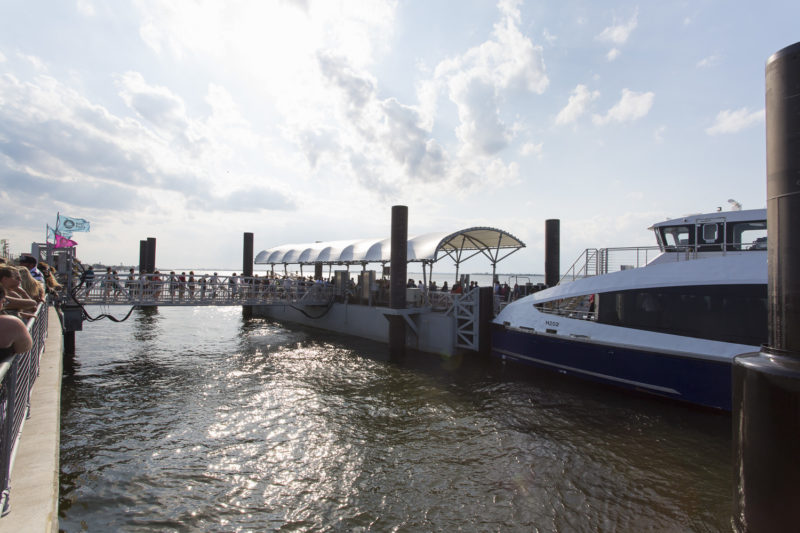After passing its millionth passenger mark in just three months of operation, the NYC Ferry public system is poised to open its next routes and additional landings to link commuters and waterfront neighborhoods.
With three routes now, ferry operators are scrambling to handle high demand, as riders complain about delays and packed 150-passenger boats. In late August a fourth route will be launched linking Astoria in Queens to Long Island City North, Roosevelt Island, and the East 34th St. and Wall Street Pier 11 landings in Manhattan.
With a fleet of 20 Incat Crowther-design aluminum catamarans to be completed, the New York City Economic Development Corporation, which oversees the system operated by NYC Ferry by Hornblower, has ordered the last three vessels from Horizon Shipbuilding Inc., Bayou La Batre, Ala., to be increased to 250-passenger capacity ferries.
Two more routes, Soundview from the Bronx, and a Lower East Side ferry, are to open in 2018. One Soundview stop will be at East 90th St. on the Upper East Side. But EDC officials announced Tuesday that plans for another Soundview Manhattan stop at East 62nd St. are being dropped because of safety concerns related to East River commercial traffic.
The proposed stop would let riders off close to Midtown and the Upper East Side, but “would pose serious safety concerns for the regulatory and maritime community that cannot be feasibly solved,” EDC officials said in a prepared statement.
“Significant barge traffic in the area and limited space in the narrow channel create risk of collision. After a thorough review of engineering options and operational alternatives, NYCEDC and harbor regulators determined such safety risks outweighed the benefits of having a ferry landing at that location on the East River.”
Instead, the Soundview boats will stop at the East 34th St. landing, so the route “will guarantee three stops in Manhattan,” according to the agency.
Those landings are designed by the McLaren Engineering Group in New York, whose marine structural engineering team has designed and built floating ferry landing concepts since the mid-1980s. For the NYC Ferry, the landings are a $55 million component of the project.
McLaren is providing engineering consulting services on 11 new landings and several upgraded sites including design, planning, project coordination, permitting, and procurement and construction administration.
The typical ferry landing is a barge, fabricated on Staten Island, secured on vertical pilings so it rises and falls with the tide and can accommodate multiple vessels with various freeboards. One condition form the designs is compliance with New York’s Local Law 68 on passenger accessibility, so the landings provide ease of pedestrian and handicapped access.

The NYC Ferry Rockaway landing. McLaren Engineering Group photo.
Other aspects provide by McLaren include fendering and vessel impact design, accessibility design, canopy, gates and railings, windscreens, navigational piles, and the upland gateways with power and wayfinding signage.
“After studying the proposed landing sites to ensure the locations were viable, we implemented our fast track designs, which we have refined over the last 30 years,” Shea Thorvaldsen, McLaren’s marine division manager, said in a company statement. “We then determined how to get the riders safely onboard, power to the site, and how to minimize the impact of the landings on the surrounding neighborhood,”
“To create a viable low-profile landing, with protection from the environment was a challenge. The canopy and windscreens are always seen as a visual impediment to the environment, and the budgets were tight. In the end, the city now has landings that are accessible, safe, and easily maintained, as well as aesthetically pleasing with the surrounding environment,” said Thorvaldsen.
“McLaren is honored to be part of this monumental project,” said Malcolm G. McLaren, president and CEO of the McLaren Engineering Group. “We helped develop the floating landing concept in New York harbor and have been for improving on it for more than 30 years. Our extensive experience prepared us to quickly design landings that link the city’s boroughs in a safe and efficient manner.”

This is what a NYC Ferry captain sees on approach to a landing. McLaren Engineering Group photo.
McLaren’s body of work includes more than 60 ferry transportation facilities in the Northeast, including some of the largest ferry terminals in the world. Those include the Battery Park Ferry Terminal at the World Financial Center in lower Manhattan, the restoration of the Lackawanna Ferry Terminal in Hoboken, N.J., and the Port Imperial terminal in Weehawken, N.J.
Along with filing with the Corps of Engineers for permits for the new landings, NYC Ferry is moving ahead on construction for its homeport at the Brooklyn Navy Yard. A 56,000-sq. ft. maintenance and storage facility will include berthing space for up to 25 boats, supplies and parts, and utilities, including a 40,000-gal. diesel fueling system. EDC officials say it will be fully equipped by early 2018.





